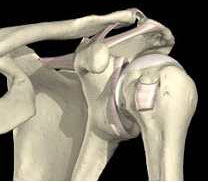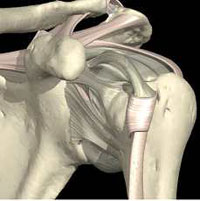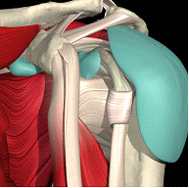Anatomy of the Shoulder Joint
The shoulder joint is a sophisticated mechanism that serves as the central connection between the body and the upper limbs. Its functioning, strength, and stability are vital to allow the hand to move in space and perform its normal activities interactively with the surrounding environment.
This joint is one of the three largest joints in the human body (along with the hip and knee joints), and unlike the latter two, it is a hanging joint and not weight-bearing. As such, the key connecting role is played by the soft tissues (ligaments, tendons, and capsule) designed by nature to function in perfect harmony. Disruption of this complex balance would create problems in the normal functioning of this joint.
The shoulder joint consists of three bones:
Scapula, clavicle, and humerus.
The scapula is a flat bone consisting of the body, which is the broad part, the spine, which is an anatomical formation on the back part of the body, acromion, which is the top of the shoulder blade, and the coracoid process, which forms a projection on the front part of the shoulder blade. These three bones are interconnected by ligaments and joints that facilitate movements of the bones and anatomical structures fixed to them.

The joints are:
- Sternoclavicular
- Acromioclavicular
- Glenohumeral
- Scapulothoracic
The ligaments of the shoulder joint are:
Coracoclavicular ligament (important for anteroposterior stability of the acromioclavicular joint)
Acromioclavicular ligament (important for superoinferior stability of the acromioclavicular joint)
Coracoacromial (forms a protective arch over the head of the humerus, preventing superoinferior instability. This ligament is crucial to preserve during arthroscopic decompression procedures in cases of unreparable rotator cuff tears.)
Glenohumeral (three ligaments - superior, middle, and inferior - the most important of which is the Inferior Glenohumeral Ligament, which constitutes the primary stabilizer of the shoulder joint)
The capsule is an anatomical structure of the shoulder joint that surrounds it and, in specific positions, forms the glenohumeral ligaments.

The shoulder blade serves as a supporting base for many anatomical structures. From this, numerous muscles start, connecting this bone to other structures, e.g., the humerus, through muscles that end in extensions consisting of elastic tissues called ligaments. All these ligaments collectively envelop the head of the humerus, forming the "rotator cuff." The components of this structure and their functions are listed below:
- The tendon of the supraspinatus covers the upper part of the head of the humerus, and the supraspinatus muscle is responsible for lifting the arm sideways, especially in the first 30 degrees.
- The tendon of the subscapularis covers the upper part of the head of the humerus, and the subscapularis muscle is responsible for internal rotation of the arm.
- The tendon of the infraspinatus covers the posterior part of the head of the humerus, and the infraspinatus muscle is responsible for the external rotation of the arm.
- The tendon of the teres minor covers the posterior part of the head of the humerus beneath the tendon of the infraspinatus. The teres minor muscle is responsible for the external rotation of the arm when the latter is raised.
- In the front part of the shoulder joint, two anatomical positions are observed on the shoulder blade, corresponding to the two tendon heads (long and short head) of the biceps brachii muscle.
At points where the tendons that make up dynamic structures pass near the bony surfaces that make up static structures, several membrane-like sacs called bursae are found. The role of bursae is to lubricate and facilitate the movement of tendons with minimal friction. Several bursae are noticed, but the largest and most important is the subacromial bursa. If this bursa is traumatized or irritated, it can become a source of friction for the tendons in the lower part of the acromial bone, resulting in the onset of shoulder pain.
The shoulder joint is traversed by a dense network of blood vessels and nerves. Understanding these anatomical structures is of particular importance to comprehend various pathologies of this very complex joint and to avoid damaging them during open or arthroscopic operative techniques.

The most important innervation is provided by:
- Axillary nerve, which innervates the deltoid muscle, the largest muscle of the shoulder joint.
- Suprascapular nerve, which innervates the supraspinatus and infraspinatus muscles.
- Musculocutaneous nerve, which innervates the biceps and brachialis muscles.
- Accessory nerve, which innervates the trapezius muscle.
My arm hurt a year ago especially when the weather changed so much that I couldn't move it. Especially when I raised it up. I have done a lot of swimming this year and surprisingly now I can rotate it easily without feeling any pain. I didn't use any medication. I found this material very interesting and informative, but I wish it had more explanations in layman's terms and how we can keep our arm from getting hurt. Because I still don't know why I experienced that kind of pain. Thank you for your understanding
Sent by aida kaziaj, më 09 January 2012 në 14:33
I have worked as a turner for 25 years in Greece, now I have a pain in my right arm that starts in the shoulder, affects the muscle, and the inner part of the forearm. The pain starts at two points on the shoulder, on the left and the right side of the shoulder. I can move my arm normally during the day, but at night it's a problem; I can't sleep, I have a lot of pain. What should I do, please give me some advice, thank you for your understanding
Sent by Besnik Jahollari, më 31 January 2015 në 02:05
I have a front shoulder ligament injury, but I can't find a cure since I was injured on 12/09/2019, I can't recover, I have pain and can't move my arm from behind, can you give me any advice?
Sent by Kujtim Elbasani, më 04 April 2020 në 15:06
Hello. Send to this email: banosath@yahoo.gr more detailed information regarding your problem as well as send the analyses or examinations that you have conducted. All the best
Replay from Artan Bano, më 05 April 2020 në 06:05